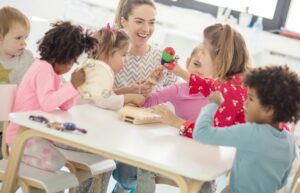Multisensory Spaces – by Elena Lewis, Occupational Therapist at Bellavista School
There are five familiar sensory systems – sight, sound, smell, taste, and touch. The three we’re not so familiar with are – vestibular (balance), proprioceptive (movement) and interoceptive (internal). The human body receives information about the world from the full sensory system and the brain organises sensory input by filtering out irrelevant information to allow for learning and participation in day-to-day tasks. But what happens when our brain is not able to filter out irrelevant stimuli?
Imagine being in an environment where your sensory systems are unregulated and out of your control. You might hear the constant buzzing sound of fluorescent light and be unable to block it out. Somebody standing too close to you, touching you may be intolerable. The texture of your clothes may feel like a cactus scratching your skin. This ‘sensory overload’ would result in the disruption of your normal functioning.
Often children who present with sensory processing disorders, ADHD, anxiety, and other challenges, find themselves in environments that dysregulate them and impair their ability to participate. Most environments are multi-sensory environments e.g., classrooms, shopping centres, social gatherings etc… and it is difficult for them to filter out irrelevant stimuli and to self-regulate. It is therefore important to provide structured multi-sensory environments that provide a safe space to regroup, regulate, unwind, and even practice mindfulness. It may be helpful to create this in the comfort and ‘safety’ of your own home.
This can be done with relative ease. The idea is to create an environment where there is you can control the amount of light, array of colours, sound levels, type of movement and textures experienced. When we can control our environment, it brings a sense of calm, regulation, and mindfulness. This applies to both adults and children alike.
Create your own multi-sensory space at home
Let’s look at a few ideas within each sensory system that are accessible in many homes or can be easily sourced. This can be done in a corner of a child’s room or a specific space in the home. Remember to make sure that this does not become a punitive approach e.g., “You are being naughty, go to your calm down space.” but rather “I see you are feeling a bit upset / angry / frustrated, should we go and explore your sensory space and see what will make you feel better?”
|
Sight |
Coloured light bulbs e.g., blue, red, or green Fairy lights LED strips that change colour Reduced pictures or posters on the wall Black-out curtains Simple light projector/night light A closed-off tent or fort made with chairs and linen DIY Glitter jars |
|
Touch |
A fiddler box – poppets, bubble wrap, pipe cleaners, stress balls, sponges, putty or playdough Weighted blankets, happy huggers, weighted toys Soft toys Hot water bottle |
|
Sound |
Music – Bluetooth speaker or earphones Noise cancelling headphones, or headphones which cover the ears and will dull external sound |
|
Taste |
Crunchy snacks – popcorn, nuts, biltong Silicone chewers/chewable jewellery Chewing gum Bubbles Balloons |
|
Smell |
Most people associate smell with experiences, and these are very individualised. If you choose to use essential oils or diffuses in your sensory space it would be specific to the needs of the person. |
|
Movement |
Gym ball (to bounce on, roll over, sit on etc) Mini trampoline Beanbag Hula-hoops Downward dog Hammock |
About Bellavista SHARE
Bellavista S.H.A.R.E. is the Education Resource Centre of Bellavista School, an independent school in Johannesburg that is widely regarded as a centre of excellence in the field of remedial education. With the Bellavista S.H.A.R.E initiative, the school harnesses the collective capacity it holds within its own staff to improve the quality of educational delivery in Southern Africa by sharing its wealth of professional knowledge, experience, and collective expertise with the community of educators and health professionals working with children in the region.



